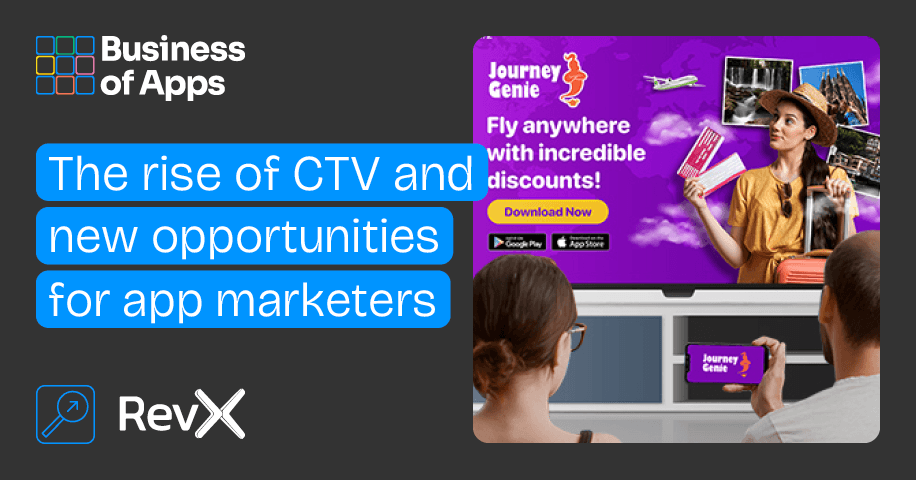As smartphones became an integral part of everyday life, marketing evolved to keep pace, changing how brands engage with their target audiences. Marketers adapted by delivering relevant content quickly, leveraging faster internet, improved technology, and an abundance of behavioural data. This has positioned mobile programmatic advertising at the forefront of technological evolution. Today, mobile app advertising has become a dominant force in programmatic, with mobile app revenues consistently breaking growth records year after year.
Despite the vast array of apps available, consumers remain loyal to their TV screens—whether for shows like the final season of Game of Thrones or live sports events like the World Cup, the Champions League, or the Super Bowl. Perhaps it’s time for app marketers to revisit and reconsider their marketing mix, especially with Connected TV (CTV) gaining prominence.
While phones remain the most-used devices, projected to reach 238 minutes of daily usage by 2025 (according to eMarketer), CTV is rapidly catching up as Smart TV adoption skyrockets. In 2024 alone, 30.1 billion hours were streamed on Roku, and this trend is set to expand, particularly in regions like Brazil, Mexico, and the Asia-Pacific (APAC), where Smart TV usage is on the rise.
With the increasing number of CTV devices worldwide, brands now have an exciting opportunity to connect with audiences in new ways. CTV combines powerful targeting capabilities with engaging storytelling, offering a fresh and innovative way for brands to reach households.
In this piece, we will explore the brief history of Connected TV—how it emerged, how it differs from Over-the-Top (OTT) media, and why it matters to modern app marketers. We will also uncover the advantages and key considerations for incorporating CTV into your marketing strategy, helping you gain a competitive edge in today’s rapidly evolving landscape.
CTV by the numbers
Source: RevX
Brief history of CTV
Connected TV refers to any physical TV set connected to the internet. These include Smart TVs, TV streaming sticks, and gaming consoles. CTV advertising on the other hand is the inventory bought and sold and then displayed via CTV devices.
CTV has gained much media attention and focus in the AdTech space lately, but it’s not a newcomer. As streaming services and devices have been a part of early adopters’ living rooms for over a decade.
Netflix paved the way for the category by revolutionizing how viewers consumed entertainment. Roku was also early to the scene, offering an alternative stand-alone option for streaming titles to internet-connected television from a remote control.
Later, ad-supported video-on-demand (AVOD) platforms like Hulu, YouTube, and other emerging streaming services, such as Tubi and Peacock (NBCUniversal Media Group), launched ad-supported models. With the new supply, consumers’ habits changed and they opted to watch the ads in exchange for on-demand access to stream over-the-top content, ranging from video and audio to live TV.
Simply put, OTT is the method of delivering content–whether consumed via mobile, desktop, or Smart TVs. OTT streaming content goes “over” the conventional content schedule of a service provider such as broadcast, cable, or satellite TV stations.
This change in content models further led marketers to shift budgets from traditional linear TV to CTV advertising. Programmatic CTV advertising also began to find its footing, which enabled real-time bidding (RTB) for CTV inventory similar to how ads were served on desktop and mobile web environments.
A significant shift occurred after the start of the COVID-19 pandemic that has forever changed the category and consumers’ reliance on these comforts and services. “Cutting the cord” became a household phenomenon, wherein people let go of their expensive cable TV service providers and opted for subscriptions to internet-streaming services. An entire generation of younger Millennials and Gen Z has skipped this phase, opting for streaming and smart TVs from the get-go.
Two important factors have made CTV advertising the darling of app marketers in 2024:
- Effective targeting through data: CTV enables advertisers to leverage geographic and behavioural data, making ads far more relevant compared to traditional TV spots.
- Household-level targeting: Rather than showing the same ad to all viewers, CTV allows for tailored ads to be served to different households—and their connected devices—based on specific criteria.
CTV and why it matters to app marketers
Connected TV (CTV) devices and streaming services untethered to programmed TV schedules have introduced novel advertising formats. In current environments, users engage with your brand in a different setting from mobile or web, allowing for unique opportunities to build awareness while keeping them entertained.
Interestingly, this up-and-coming channel also offers incredible crossover capabilities. With myriad targeting and audience segmentation, creative freedom mirroring storytelling legacies from linear TV, and seamless tie-ins across channels and devices, CTV can elevate full-funnel campaigns—from Branding and User Acquisition (UA) to Retargeting (RT). All reaching new heights for both branding and performance marketers.
Simply put, CTV holds enormous potential for advertisers. Ad spending in this space is projected to grow 22.4% in the United States alone in 2024, according to eMarketer. And tackling it through a multi-channel approach can add phenomenal layers of branding and holistic discovery moments, driving the success of your app.
What’s in it for marketers?
After being a longtime staple in global households and public spaces (sports bars, coffee shops, gyms, community centres), linear TVs have given way to the high adoption of SmartTVs, stand-alone streaming devices (such as Roku, Apple TV, Tizen OS (Samsung), Google Chromecast OS, Amazon Fire), and gaming consoles, which have all played their part in this massive shift in behaviour and consumption.
In 2023, Statista reported that 88% of US households had at least one internet-connected device at home. While the rest of the world gains traction, the US continues to lead in CTV adoption and advertising spending.
Bigger screens and distinct global inventory, combined with the fact that most viewers are in peak comfort mode at home when watching their CTV make an interesting testing area for user acquisition and branding. Following the success of mobile advertising and the key performance indicators (KPIs) developed amongst top brands and performance marketers, CTV provides a unique, scalable, and multi-device proposition for comprehensive campaigns that blend channel methodologies.
As app businesses are constantly seeking new channels to connect with their audience, CTV emerges as an ideal option due to its growing popularity and ability to reach a broader and engaged audience.
Reasons to adopt CTV to your app’s marketing mix
- Massive scale: Broader reach with medium that remains relatively undersaturated, offering significant opportunities for growth.
- Desirable target audience: Reach savvy, high-value users, similar to engaged mobile users, with the potential for effective targeting and segmentation.
- Immersive experience: Capture users in relaxed environments on larger screens, encouraging cross-device and multi-screen interaction.
- Creative expression and emotive copy: Leverage the power of on-screen storytelling and the emotional connections fostered through entertainment to showcase your brand’s value proposition in a compelling and relevant way.
- Capture attention: Unskippable ads and ad pods provide brands with the opportunity to make a lasting impression through varied, back-to-back messaging.
Things app marketers should keep in mind with CTV
Audience shifts
As CTV has evolved from traditional TV advertising, the availability of certain inventory—particularly in specific regions or languages—may not yet meet the growing demand. This can limit reach in some markets. However, with 98% of internet-connected households accessible through open programmatic CTV ads, the broader reach and personalization potential should still be considered.
Adjusting habits
CTV ads are not clickable unlike their mobile ad counterparts, and served video impressions will not lead directly to app install pages. While this may seem like a drawback, it also encourages app marketers to craft stronger CTAs and develop creative strategies that motivate users to search for and download the app on mobile devices.
Pricing
Finally, high CPMs can be a hurdle—or at least a data point to get accustomed to—for many app marketers as they navigate a new spending category. It’s crucial to partner with trusted technology providers who offer clear, transparent data to help optimize for a strong return on ad spend (ROAS).
Protected inventory
Finding transparent CTV partners with protected inventory is important to the quality of your campaigns. Like the ad inventory available for web and mobile, ad fraud is a topic marketers need to be aware of and take precautionary measures to limit. Advertisers should be keen to mitigate their exposure to bot fraud, the use of fraudulent ad exchanges, and unethical reporting of audience extension services.
In summary
CTV holds a number of unique characteristics that make it an imperative choice for the savvy app marketer, especially as an addition to your media mix. This shift towards interactivity is paving the way for continued innovation in brand and performance marketing.
As with anything new, there’s a learning curve—for both the industry and users adapting to new ad formats. However, now is the perfect time to make your app stand out by trying different CTAs in ad pods and developing best practices for CTV, mobile, and cross-platform strategies.
In a competitive ad-inventory space, those who can stick through the initial warm-up or experimentation phase will be able to pivot campaigns more effectively down the road, as both consumers and the adtech industry adapt and CTV continues to evolve.
If you have any questions about launching a CTV ad campaign or enhancing your current CTV campaign performance, feel free to reach out to our team of CTV experts.













